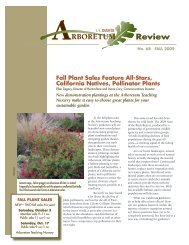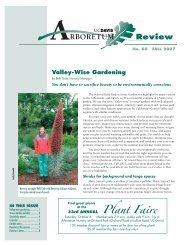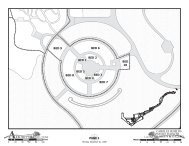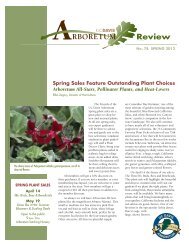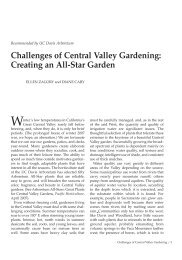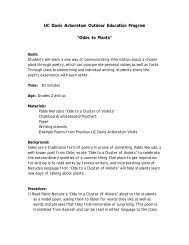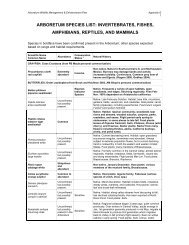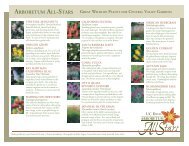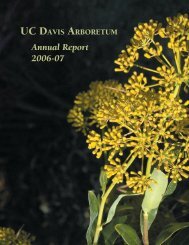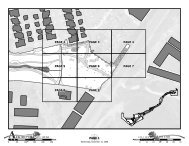Recommended Plants for Central Valley Gardens - the UC Davis ...
Recommended Plants for Central Valley Gardens - the UC Davis ...
Recommended Plants for Central Valley Gardens - the UC Davis ...
Create successful ePaper yourself
Turn your PDF publications into a flip-book with our unique Google optimized e-Paper software.
14<br />
<strong>Recommended</strong> <strong>Plants</strong> <strong>for</strong> <strong>Central</strong> <strong>Valley</strong> <strong>Gardens</strong><br />
ShRubS<br />
Arctostaphylos densiflora ‘Howard McMinn’<br />
– Vine Hill manzanita: Cali<strong>for</strong>nia native plant; known <strong>for</strong> its<br />
smooth, wine-red bark; one of <strong>the</strong> few manzanitas that tolerates<br />
our clay-loam soils; attracts hummingbirds and beneficial<br />
insects.<br />
Berberis aquifolium ‘Compacta’ – compact<br />
Oregon grape: Cali<strong>for</strong>nia native plant; dark, grape-like fruits<br />
provide food <strong>for</strong> native birds and can be made into preserves;<br />
tough plant that tolerates a variety of garden conditions;<br />
attracts beneficial insects and birds.<br />
Callistemon ‘Violaceus’ – purple bottlebrush: Rosypurple<br />
“bottlebrush” flowers bloom in early winter and spring,<br />
and sporadically year round; medium to large evergreen shrub<br />
that is tough and adaptable; grows best in full sun and tolerates<br />
infrequent watering; attracts hummingbirds and beneficial<br />
insects.<br />
Calycanthus occidentalis – western spice bush:<br />
Cali<strong>for</strong>nia native plant; maroon-red flowers attract pollinating<br />
beetles; leaves have a sharp, clean fragrance and turn yellow in<br />
<strong>the</strong> autumn, adding seasonal color to <strong>the</strong> garden.<br />
Carpenteria cali<strong>for</strong>nica – bush anemone: Cali<strong>for</strong>nia<br />
native plant; has clusters of large, sweetly-scented white<br />
flowers in late spring and early summer; glossy, dark-green<br />
leaves stay on <strong>the</strong> plant all year; older stems have attractive,<br />
pale, papery bark.<br />
Ceanothus ‘Concha’ – concha ceanothus: Cali<strong>for</strong>nia<br />
native plant; one of <strong>the</strong> best Cali<strong>for</strong>nia lilacs <strong>for</strong> <strong>the</strong> garden<br />
with dark-green leaves all year; showy, deep blue flowers<br />
with reddish bracts bloom in spring; attracts beneficial insects.<br />
Ceanothus maritimus ‘<strong>Valley</strong> Violet’ – valley<br />
violet maritime ceanothus: Cali<strong>for</strong>nia native plant; best small<br />
ceanothus <strong>for</strong> <strong>Central</strong> <strong>Valley</strong> gardens; clusters of dark-violet<br />
flowers bloom in spring; attracts beneficial insects.<br />
Ceanothus x pallidus ‘Marie Simon’ – Marie<br />
Simon ceanothus: Large, loose clusters of soft-pink flowers<br />
complement maroon-red stems; nectar-rich flowers attract<br />
bees and o<strong>the</strong>r beneficial insects; semi deciduous to evergreen.<br />
Daphne odora ‘Aureomarginata’ – winter<br />
daphne: Shiny variegated leaves are attractive all year;<br />
requires little maintenance; intensely fragrant flowers<br />
perfume cool winter air.<br />
Dasylirion wheeleri – desert spoon: Evergreen desert<br />
plant with long, narrow, blue-gray leaves; cream-colored<br />
flowers emerge in summer on tall spikes; drought tolerant and<br />
makes a striking accent plant; attracts beneficial insects.
arboretum<br />
location<br />
size<br />
bloom<br />
season<br />
exposure<br />
Pruning<br />
needs<br />
water<br />
needs<br />
water<br />
instructions<br />
ATG medium winter little or none water deeply<br />
once or twice a<br />
month<br />
ATG small winter,<br />
spring<br />
ATN large winter,<br />
spring,<br />
summer<br />
little or none water deeply<br />
every two<br />
weeks<br />
little or none;<br />
prune to shape<br />
MWB large spring little or none;<br />
prune to shape<br />
DC medium spring little or none;<br />
prune to shape<br />
ATN medium spring little or none;<br />
prune to shape<br />
after spring<br />
flowering<br />
MWB small winter little or none;<br />
prune to shape<br />
after spring<br />
flowering<br />
RRS medium spring prune in early<br />
spring to shape<br />
and remove<br />
old, twiggy<br />
growth<br />
water deeply<br />
once or twice a<br />
month<br />
water deeply<br />
once or twice a<br />
month<br />
water deeply<br />
once or twice a<br />
month<br />
water deeply<br />
once or twice a<br />
month<br />
water deeply<br />
once or twice a<br />
month<br />
water deeply<br />
once or twice a<br />
month<br />
RRS small winter little or none water deeply<br />
every one to<br />
two weeks<br />
RRS small spring,<br />
summer<br />
little or none water deeply<br />
once or twice<br />
a month or not<br />
at all<br />
15
16<br />
<strong>Recommended</strong> <strong>Plants</strong> <strong>for</strong> <strong>Central</strong> <strong>Valley</strong> <strong>Gardens</strong><br />
ShRubS<br />
Eriogonum giganteum – Saint Ca<strong>the</strong>rine’s lace:<br />
Cali<strong>for</strong>nia native plant; large clusters of white flowers appear in<br />
summer and attract beneficial insects; fast growing and quickly<br />
develops into a large, rounded shrub with woolly, whitish-gray<br />
foliage.<br />
Hesperaloe parviflora – coral yucca: Adds a strong<br />
architectural note to <strong>the</strong> garden with its attractive spiky-looking<br />
leaves; very heat and drought tolerant; blooms all summer long;<br />
attracts hummingbirds.<br />
Isomeris arborea – bladderpod: Cali<strong>for</strong>nia native plant;<br />
one of <strong>the</strong> only native shrubs that blooms year round; yellow<br />
flowers attract beneficial insects and hummingbirds to <strong>the</strong><br />
garden and <strong>the</strong>n develop into attractive seed pods.<br />
Jasminum nudiflorum – winter jasmine: Bright yellow<br />
flowers cheer up <strong>the</strong> winter garden; use as an arching shrub or<br />
can be trained as a cascading vine; glossy, dark-green stems<br />
are revealed in winter.<br />
Lavandula x ginginsii ‘Goodwin Creek Grey’<br />
– Goodwin Creek lavender: Long bloom season; easy to<br />
renew with pruning; more heat resistant than English lavenders;<br />
attracts hummingbirds and beneficial insects.<br />
Lavandula stoechas ‘Otto Quast’ – Otto Quast<br />
Spanish lavender: Showiest of all <strong>the</strong> lavenders; thrives in<br />
sunny dry conditions; attracts butterflies and beneficial insects.<br />
Leucophyllum frutescens – cenizo (”Texas ranger”):<br />
Striking silvery foliage; very heat and drought tolerant; requires<br />
little pruning as a shrub but can be successful as a hedge if<br />
sheared; attracts beneficial insects.<br />
Leucophyllum langmaniae ‘Lynn’s Legacy’ –<br />
Lynn’s legacy leucophyllum: Showy, bright, lavender-violet<br />
flowers bloom through spring and summer; dense-growing,<br />
medium-sized shrub has fuzzy, light-green leaves all year; very<br />
adaptable plant that tolerates heat, wind, and alkaline soil.<br />
Lonicera standishii – winter honeysuckle: Distinctive<br />
fountain-shaped shrub; deliciously fragrant white flowers adorn<br />
<strong>the</strong> semi-leafless stems during winter and early spring; attracts<br />
hummingbirds in winter.<br />
Philadelphus ‘Belle Etoile’ – purple spot mock<br />
orange: Good choice <strong>for</strong> <strong>the</strong> back of a perennial border; spring<br />
bloom is very showy and stands out in <strong>the</strong> moonlight; attractive<br />
vase-shaped <strong>for</strong>m.
arboretum<br />
location<br />
size<br />
bloom<br />
season<br />
exposure<br />
Pruning<br />
needs<br />
CC medium summer remove old<br />
flower stalks;<br />
prune to<br />
maintain<br />
compact <strong>for</strong>m<br />
RRS small summer,<br />
fall<br />
DC medium winter,<br />
spring,<br />
summer,<br />
fall<br />
remove old<br />
flower stalks in<br />
winter<br />
RRS small winter little or none;<br />
prune to shape<br />
RRS small spring,<br />
summer,<br />
fall<br />
ATG<br />
RRS<br />
water<br />
needs<br />
water<br />
instructions<br />
water deeply<br />
once or twice a<br />
month<br />
water deeply<br />
once or twice a<br />
month<br />
little or none water deeply<br />
once a month<br />
cut back after<br />
flowering<br />
small spring cut back to<br />
remove old<br />
flowers and<br />
keep compact<br />
RRS large summer little or none;<br />
prune to shape<br />
RRS medium spring,<br />
summer<br />
water deeply<br />
once or twice a<br />
month<br />
water deeply<br />
every two<br />
weeks<br />
water deeply<br />
every two<br />
weeks<br />
water deeply<br />
once or twice a<br />
month<br />
little or none water deeply<br />
once or twice a<br />
month<br />
EAC medium winter little or none water deeply<br />
every one to<br />
two weeks<br />
WFG large spring,<br />
summer<br />
cut older stems<br />
to ground to<br />
rejuvenate<br />
water deeply<br />
every one to<br />
two weeks<br />
17
18<br />
<strong>Recommended</strong> <strong>Plants</strong> <strong>for</strong> <strong>Central</strong> <strong>Valley</strong> <strong>Gardens</strong><br />
ShRubS<br />
Phlomis purpurea – pink phlomis: Showy, lavenderpink<br />
flowers bloom in summer, with scattered blossoms all year<br />
long; small shrub that is tolerant of heat and dry soils; velvety,<br />
yellow-green leaves stay on <strong>the</strong> plant all year.<br />
Ribes aureum – golden currant: Cali<strong>for</strong>nia native plant;<br />
flowers have a light, spicy fragrance; good choice <strong>for</strong> planting<br />
under native oaks; attracts butterflies and beneficial insects.<br />
Ribes malvaceum – chaparral currant: Cali<strong>for</strong>nia native<br />
plant; pale-pink winter flowers attract hummingbirds; drought<br />
tolerant with scented leaves.<br />
Rosa ‘Korbin’ – Iceberg® rose: Tough and disease<br />
resistant; tolerates some shade; can be trained, with pruning, to<br />
be a medium or large shrub.<br />
Rosa ‘Perle d’Or’ – golden pearl polyantha rose: Fine<br />
shrub rose <strong>for</strong> <strong>Central</strong> <strong>Valley</strong> gardens; has fewer thorns than<br />
most roses; drought resistant.<br />
Rosa ‘Pink Grüss an Aachen’ – Grüss an Aachen<br />
floribunda rose: This rose has beautiful, showy, fragrant pink<br />
flowers in clusters followed by attractive ornamental fruits;<br />
requires afternoon shade to protect <strong>the</strong> flowers from sunburn.<br />
Rosa x odorata ‘Mutabilis’ – butterfly rose: Has<br />
showy, single flowers nearly year round; flowers attract<br />
pollinating bees and o<strong>the</strong>r beneficial insects; new burgundy<br />
stems complement multi-colored flowers.<br />
Rosmarinus officinalis ‘Mozart’ – Ed Carman’s<br />
rosemary: Evergreen shrub with dark-green leaves that are rich<br />
in aromatic oils and prized <strong>for</strong> cooking; this variety has one of <strong>the</strong><br />
darkest blue flowers of any rosemary; blooms from spring through<br />
summer and often again in fall; attracts beneficial insects.<br />
Salvia apiana – Cali<strong>for</strong>nia white sage: Cali<strong>for</strong>nia native<br />
plant; spring flowers attract pollinating bees; leaves contain<br />
fragrant oils.<br />
Salvia clevelandii ‘Winnifred Gilman’ –<br />
Winnifred Gilman Cleveland sage: Cali<strong>for</strong>nia native plant;<br />
evergreen shrub produces maroon-stemmed, blue-violet<br />
flowers; heat and drought tolerant; attracts hummingbirds,<br />
butterflies and beneficial insects.
arboretum<br />
location<br />
size<br />
bloom<br />
season<br />
MC small spring,<br />
summer<br />
ATG large winter,<br />
spring<br />
MWB medium fall,<br />
winter<br />
WFG medium spring,<br />
summer,<br />
fall<br />
RRS medium spring,<br />
summer,<br />
fall<br />
RRS medium spring,<br />
summer,<br />
fall<br />
ATG large spring,<br />
summer,<br />
fall<br />
exposure<br />
Pruning<br />
needs<br />
remove old<br />
flower stalks;<br />
prune to<br />
maintain<br />
compact <strong>for</strong>m<br />
water<br />
needs<br />
water<br />
instructions<br />
water deeply<br />
once or twice a<br />
month<br />
little or none water deeply<br />
every one to<br />
two weeks<br />
little or none water deeply<br />
once or twice a<br />
month<br />
prune in<br />
winter; remove<br />
old flowers<br />
through bloom<br />
season<br />
prune in<br />
winter; remove<br />
old flowers<br />
through bloom<br />
season<br />
prune in<br />
winter; remove<br />
old flowers<br />
through bloom<br />
season<br />
remove old<br />
stems to<br />
base; prune in<br />
winter to keep<br />
compact<br />
ATN small winter little or none;<br />
prune to<br />
maintain<br />
compact <strong>for</strong>m<br />
MWB small spring remove old<br />
flower stalks<br />
once a year<br />
ATN small spring remove old<br />
flower stalks in<br />
summer; prune<br />
to maintain<br />
compact <strong>for</strong>m<br />
water deeply<br />
every one to<br />
two weeks<br />
water deeply<br />
every one to<br />
two weeks<br />
water deeply<br />
every one to<br />
two weeks<br />
water deeply<br />
every one to<br />
two weeks<br />
water deeply<br />
once or twice a<br />
month<br />
water deeply<br />
once or twice a<br />
month<br />
water deeply<br />
once or twice a<br />
month<br />
19
20<br />
<strong>Recommended</strong> <strong>Plants</strong> <strong>for</strong> <strong>Central</strong> <strong>Valley</strong> <strong>Gardens</strong><br />
ShRubS<br />
Salvia greggii and Salvia x jamensis – autumn<br />
sage: Showy flowers attract hummingbirds and beneficial<br />
insects; flowers profusely in <strong>the</strong> spring and fall.<br />
Salvia microphylla – mint bush sage: Leaves have a<br />
fruity smell; good <strong>for</strong> growing under native oaks; thrives with<br />
little care in sun or part shade; attracts hummingbirds.<br />
Sollya heterophylla – Australian bluebell creeper:<br />
Bushy, evergreen climber can be used ei<strong>the</strong>r as a small shrub<br />
or vine; bell-shaped pink flowers bloom from summer through<br />
fall; drought tolerant with glossy, deep-green leaves.<br />
Syringa x laciniata – cut leaf lilac: Attractive, lacy<br />
foliage; more drought tolerant and disease resistant than o<strong>the</strong>r<br />
lilacs; fragrant flowers.<br />
Teucrium fruticans – bush germander: Tough,<br />
drought-tolerant shrub with no disease problems; makes a<br />
low, in<strong>for</strong>mal hedge; silvery leaves and stems brighten sunny<br />
or shady gardens; attracts beneficial insects.<br />
Viguiera parishii – desert goldeneye: Cali<strong>for</strong>nia native<br />
plant; golden daisies blossom from early spring until mid-fall<br />
among triangular-shaped green leaves; tolerates full sun or part<br />
shade and is low maintenance.<br />
TREES<br />
Acacia boormanii – Snowy River wattle: Fragrant<br />
yellow flowers add color to <strong>the</strong> winter garden; very adaptable<br />
and hardy, grows best in well-drained soils; heat and drought<br />
tolerant.<br />
Acca sellowiana (Feijoa sellowiana) –<br />
pineapple guava: Attractive spring flowers are edible and<br />
sweet; large green berries have a pineapple-like flavor; can be<br />
used as hedging or as a screen; attracts hummingbirds.<br />
Arbutus andrachne – Turkish madrone: Large clusters<br />
of greenish-white, urn-shaped flowers are followed by brilliant,<br />
orange to red berries that last into winter; smooth, reddishbrown<br />
bark peels to reveal young, pale-green bark underneath;<br />
tolerant of heat and alkaline soil conditions; attracts hummingbirds<br />
and butterflies.<br />
Ceanothus ‘Ray Hartman’ – Ray Hartman Cali<strong>for</strong>nia<br />
lilac: Cali<strong>for</strong>nia native plant; one of <strong>the</strong> best ceanothus<br />
cultivars <strong>for</strong> gardens because it can tolerate some summer<br />
irrigation; makes a good screen or small garden tree.
RRS<br />
ATG<br />
arboretum<br />
location<br />
size<br />
bloom<br />
season<br />
small spring,<br />
summer,<br />
fall<br />
RRS small winter,<br />
spring,<br />
summer,<br />
fall<br />
AC medium spring,<br />
summer<br />
exposure<br />
Pruning<br />
needs<br />
remove old<br />
flower stalks;<br />
prune to<br />
maintain<br />
compact <strong>for</strong>m<br />
RRS large spring little or none;<br />
prune to shape<br />
ATG<br />
RRS<br />
small spring,<br />
fall,<br />
winter<br />
ATN small spring,<br />
summer,<br />
fall<br />
water<br />
needs<br />
water<br />
instructions<br />
water deeply<br />
every two<br />
weeks<br />
little or none water deeply<br />
every two<br />
weeks<br />
little or none water deeply<br />
every two<br />
weeks<br />
water deeply<br />
every one to<br />
two weeks<br />
little or none water deeply<br />
once or twice a<br />
month<br />
prune plants in<br />
late winter to<br />
encourage tidy,<br />
compact <strong>for</strong>m<br />
AG small winter Little or none;<br />
prune to shape<br />
ATG small spring little or none;<br />
prune to shape<br />
Ericaceae<br />
Collection<br />
(near<br />
A St.<br />
Bridge)<br />
medium winter little or none;<br />
prune to shape<br />
in <strong>the</strong> summer<br />
water deeply<br />
once or twice a<br />
month<br />
water deeply<br />
once or twice a<br />
month<br />
water deeply<br />
once or twice a<br />
month<br />
water deeply<br />
once or twice a<br />
month<br />
MWB small spring little or none water deeply<br />
once or twice a<br />
month<br />
21





